
CHART
BOX
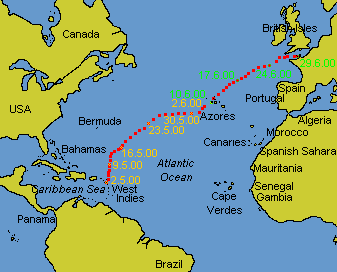
© Copyright 1999-2000 Nigel Jones, MistWeb Technology

All too soon our year was going to have to start winding up. For the story of our outward trip across the Atlantic - from Tenerife to Barbados, click here. Like all voyagers under sail, we had to follow the seasons. The long-term live-aboards who intended to stay in the Caribbean were making plans to head south, to the Grenadines or Trinidad to sit out the hurricane months. We had headed north and were ready to leave from Antigua at 0945 on the 2nd May 2000, bound for Faial in the Azores.
 | CHART |
 | |
| Sketch Maps and Chartlets (not to be used for navigation!) © Copyright 1999-2000 Nigel Jones, MistWeb Technology | |
It was another warm, sunny morning and we had decided to turn to port outside Falmouth Harbour and motor-sail straight into the trade winds to begin with in order to clear Antigua and then Barbuda on their windward sides. We killed the engine in the middle of the afternoon and beat into the easterly trades for the next few days. With plain sail and the first reef in the main, we kept the apparent wind 50° off the starboard bow. The wind varied from 15 up to 24 knots and we lived at 20° of heel until the 7th, when, quite suddenly we found ourselves becalmed.
We took the reef out and did our best but in that first day all we managed was to drift around in two circles, according to the GPS. We had nearly 2000 miles to go and even with a full tank and a spare 30-litre can we had enough fuel on board for only about 500 miles. We decided to live with the calms and make the best of our time in this wonderful wilderness, which is known as the Sargasso Sea.
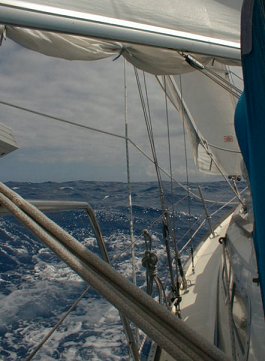 |
| When we first left Antigua we had easterly trade winds to contend with. |
Once or twice nearby thunderclouds helped the wind back into double figures. Apart from that we drifted around at 2 knots or less until the 17th May.
Day after day, the sea was completely calm. The sky was pure blue from horizon to horizon and the sea was a darker blue similarly below us. The days were hot and the water was warm. Although we decided not to leave the boat and swim, we hoisted up bucketfuls of sea-water and messed around throwing them over each other at 'bath-time' in the cockpit each day. We had fish swimming around and under the boat. Nicky tried to count them one day but lost count at 70-odd. A few pieces of sargasso weed floated by but we were never surrounded by it.
On the 11th May, Nicky wrote the following:
0600 - Nicky goes on watch - Nigel goes to sleep.
0715 - Coffee and toast for the crew.
0730 - Radio goes on: 14.121 MHz.
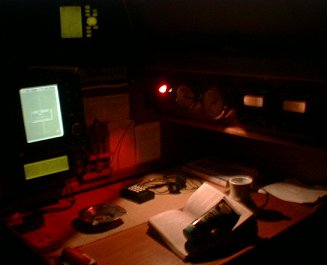 |
| The chart table became the place where we maintained our '24-hour reading marathon' for week after week at sea. This was taken late into one of Nigel's night watches. |
A few days later, Nigel wrote the following:
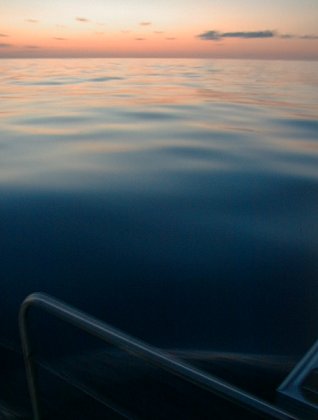 |
| Dawn in another perfect calm in the Sargasso Sea |
We are leaving the tropics behind. It is still too hot for clothes during the day but no longer so at night. A T-shirt is enough, but it is necessary.
This is, or is close to, the Sargasso Sea. We have seen a few clumps of pale sargasso weed drifting by. There are beautiful small, white birds around here, about the size of a fulmar or a black-headed gull but with a graceful forked tail. A couple of large and magnificent dark fish swum alongside the boat for a while this afternoon.
Something we haven't seen since Spain is lightning. We seem to be hemmed in by thunderstorms now. We spent much of the afternoon trying to out-run an enormous black cloud which rumbled menacingly across the south-west sky behind us. On the radar's 12-mile range it filled the lower half of the screen and threatened to embay us at less than two miles away. We got wet and a little intimidated but it eventually fragmented then evaporated where it was. Soon the sky was blue again and we missed the 6-knot sailing that the 12 to 15 knot winds had given us.
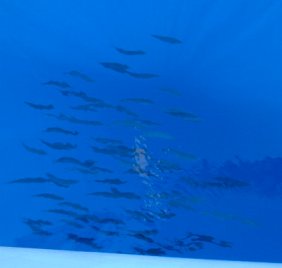 |
| Shoals of fish in the middle of nowhere often took refuge below the boat. Whether they were avoiding the sun or predatory birds in their crystal-clear water we do not know. |
The wind has been veering around our starboard side these last 24 hours as we cross the centre of the ridge of high pressure whose long southern side drives the trade winds onto Caribbean shores. After this afternoon's thunderclouds cleared the winds fell light again and out broad sails slapped and banged for some hours as our speed fell back to 1 to 2 knots.
An hour ago Nicky noticed lightning flashes out of the cabin window. We sat in the cockpit watching a couple of clouds way off our port bow as they experimented with every possible combination of lighting effects. They tried backlighting themselves, revealing a dark and intricate internal structure. Up-lighting added its usual sinister touch. The full glare of overhead arcs showed brilliant white. Obviously discontent with even these effects, angry thunderbolts were occasionally hurled from the heights into the sea surface: "Don't trifle with my beauty, my majesty or my power!"
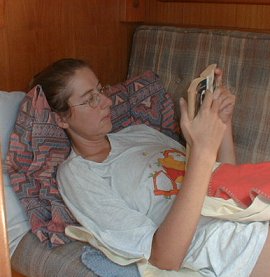 |
| Nicky passes the time in her bunk with a good book. |
We certainly would not like to be directly below such megavolts of petulance. Our cunning plan, which is to disconnect the antenna leads from all our radios and trail 10 ft (3 m) of 6 mm chain from our leeward capshroud into the sea, suddenly all seems a bit tame and inadequate.
This is all the more so as our most important radio at the moment is the amateur SSB tranceiver. We use this to check in daily to the HF maritime nets who, in turn, report our continuing progress by e-mail to anxious families and friends waiting at home. This tranceiver is connected by un-pluggable co-ax to the automatic antenna tuner but the tuner is quite seriously plumbed both to a substantial earthing plate and also the isolated majority of one of our backstays. Lightning-induced currents through this lot would silence our transmissions at the very least. They were big, expensive bits of kit and foolishly we carry no spares.
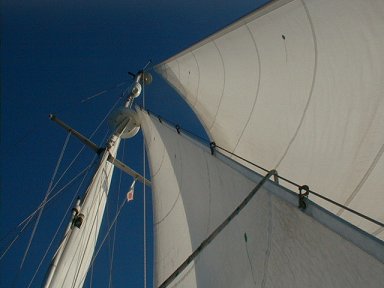 |
| Meanwhile, outside, the sails are drawing perfectly in the light winds. We did not increase sail as we were in no hurry and did not want to take any risks should a squall hit us unexpectedly. |
The lightning display ahead of us has fizzled out after 45 minutes and a pleasant breeze is wafting us north-east at 3 knots again. The storm presented itself to us in total silence and nothing showed within 24 miles on the radar so we guess it was a long way away.
The half-moon is bright among the clouds that billow around us. It all looks peaceful but we're keeping an eye, and an ear, out for any more trouble up there.